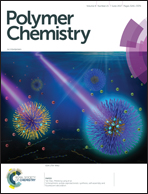Gas separation mechanism of CO2 selective amidoxime-poly(1-trimethylsilyl-1-propyne) membranes†
Abstract
Polymeric membranes for CO2 separation have drawn significant attention in academia and industry. We prepared amidoxime-functionalized poly(1-trimethylsilyl-1-propyne) (AO-PTMSP) membranes through hydrosilylation and post-polymerization modification. Compared to neat PTMSP membranes, the AO-PTMSP membranes showed significant enhancements in CO2/N2 gas separation performance (CO2 permeability ∼6000 Barrer; CO2/N2 selectivity ∼17). This systematic study provides clear guidelines on how to tune the CO2-philicity within PTMSP matrices and the effects on gas selectivity. Key parameters for elucidating the gas transport mechanism were discussed based on CO2 sorption measurements and fractional free volume estimates. The effect of the AO content on CO2/N2 selectivity was further examined by means of density functional theory calculations. Both experimental and theoretical data provide consistent results that conclusively show that CO2/N2 separation performance is enhanced by increased CO2–polymer interactions.



 Please wait while we load your content...
Please wait while we load your content...